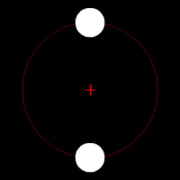Somnus (moon)
| (341520) Mors I (Somnus) | |
|---|---|
| Provisional or systematic name | S / 2005 (79360) 1 |
| Central body | (341520) Mors |
| Properties of the orbit | |
| Major semi-axis | 21,040 ± 70 km |
| Periapsis | 17,901 km |
| Apoapsis | 24,179 km |
| eccentricity | 0.1492 ± 0.0006 |
| Orbit inclination | 15.68 ± 0.22 ° |
| Orbital time | 971.7 ± 0.5 d |
| Physical Properties | |
| Albedo | 0.230 (system) |
| Medium diameter | 97 km |
| Dimensions | 7.817 · 10 17 (system) kg |
| Medium density | 0.75? (System) g / cm 3 |
| discovery | |
| Explorer | |
| Date of discovery | October 14, 2007 |
Somnus is the smaller component of the Plutino - double Systems (341520) Mors-Somnus . Its mean diameter is 97 kilometers, which is around 95.5% of the parent asteroid . This asteroid is the second to be officially classified as the moon and part of a dual system.
Discovery and naming
Somnus was discovered on October 14, 2007 by Scott S. Sheppard and Chadwick A. Trujillo during observations using adaptive optics with the Subaru / Gemini / Magellen telescopes on Mauna Kea in Hawaii . The discovery was announced on August 1, 2008, the moon was given the provisional designation S / 2007 (341520) 1 .
On June 2, 2015, Somnus received the official name together with Mors, named after the twin gods of the underworld and descendants of Nox , the goddess of the night from Roman mythology . Mors ( Latin "death") is the Roman personification of death and Somnus (Latin "sleep") that of sleep. The name was assigned under the general rules for Plutinos, who are named after gods of the underworld.
Mors-Somnus was named after Sila-Nunam in January 2012 as the second system of this type, also as a double system, which makes perfect sense due to the proportions of the two bodies. Inconsistently, Patroclus and Menoetius , who have similar proportions, were not given a double system designation beforehand (see → Nunam: The questions of a not entirely clear classification of an entire system ).
Track properties
Orbit
Somnus and Mors orbit the common barycentre on a prograde , slightly elliptical orbit at a distance between 17 901 km and 24 179 km from each other (major orbit half-axis 21 040 km, this corresponds to 412.5 Mors and 433.8 Somnus radii). The orbit eccentricity is 0.1492, the orbit is inclined 15.68 ° to the ecliptic .
Somnus and Mors circle the barycenter in 971 days, 16 hours and 48 minutes, which corresponds to 92.433 orbits ("months") in a Mors-Somnus year (245.91 earth years).
rotation
Since Mors has a known self-rotation and Somnus also has a relatively long distance to Mors, it can be assumed that Somnus does not rotate bound .
Physical Properties
size
The diameter of Somnus is 97 km, with its main body Mors being only 4.5% larger at 102 km.
internal structure
The extremely low system density of 0.75 g / cm³, which is far below that of water, indicates that water ice must be predominant on both bodies, which is not sufficient to explain the low density, however, since even pure ice with 0.91 g / cm³ is even denser. It can therefore be assumed that both bodies must have cavities inside. (→ Rubble Piles )
exploration
Since their discovery in 2007, Somnus and Mors have been observed 37 times within 5 years. (As of June 2015)
See also
- Double asteroid
- List of moons from asteroids
- List of moons of planets and dwarf planets
- List of asteroids
Web links
- How many dwarf planets are there in the outer solar system? Current list of the largest TNOs from Mike Brown
Individual evidence
- ^ Sheppard, SS, and CA Trujillo, 2008, 2007 TY 430, IAUC 8962
- ↑ 341520 Mors-Somnus at JPL
